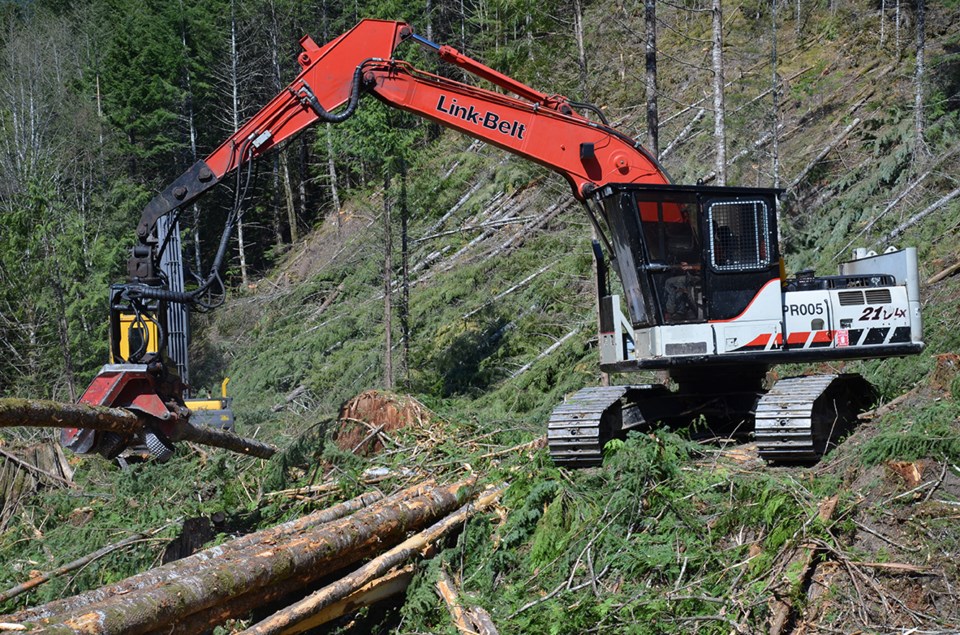One of B.C.'s leading forestry companies has announced a temporary reduction in lumber production across the province's Interior due to challenging markets and high costs, as well as log shortages. But a Squamish industry consultant says the problems in the Interior do not reflect the situation on the coast. Quite the contrary.
Over the holiday period, West Fraser Timber is significantly curtailing lumber production at its operations in Chasm, 100 Mile House, Williams Lake, and Chetwynd. But Eric Andersen, a forest industry consultant with 30 years' experience, said the challenge for the Interior is practically the opposite of the challenges facing the sector on the coast.
Andersen, who was elected to District of Squamish council in October's elections and has a role with the Squamish and District Forestry Association, spoke to The Chief in his role as an industry consultant.
"We have two forest sectors in British Columbia," he said. The species of trees, the owners of the lumber companies and the markets for the products almost all differences between the coast and the Interior, Andersen said. As a result, the challenges reflected in West Fraser's decision to reduce output have little bearing on the coast's forestry and lumber sectors.
The coast, he said, including the areas in the Sea to Sky Natural Resources District, have more wood than the market can bear. So harvests are limited not by supply, but by demand.
"We have an under-harvest… a significant under-harvest," said Andersen. In the Interior, pine beetle and spruce beetle infestations, combined with forest fires, have reduced available timber. The market for this wood — mainly spruce, pine, and sub-alpine fir — is primarily in the U.S. Higher-grade West Coast timber like Douglas fir and Western red cedar have increasingly been snapped up by Asian markets.
In the central Interior, the landscape is comparatively flat and easy to access. Squamish logging operations, by contrast, require expensive road networks to, for example, the backend of the Lillooet River or the north end of Harrison Lake. This tough terrain not only means roads are expensive to create, but precarious driving conditions can mean logging trucks may complete only two hauls per day.
Moreover, in the past, markets were willing to pay for high-quality, old-growth wood. But that quality has diminished in availability over 100 years or so of logging.
"What is left is high-cost, lesser quality timber," Andersen said.

As markets have contracted, sawmills have closed. Logs that, until 2003, were milled in Squamish are now tugged to the Fraser River or Vancouver Island. (One sizeable commercial mill and several specialty mills remain in the area, but the large-scale operation that defined the Squamish waterfront for four decades is gone.) As mills have closed, so have secondary industrial facilities that relied on their byproducts, like the pulp mill at Woodfibre. In addition to utilizing byproducts, pulp mills also used to consume lower-grade timber. The disappearance of pulp mills further reduced the demand for local loggers' resources.
Andersen hears complaints about B.C. selling raw logs to China and other overseas manufacturers.
The coast's desirable, but declining, Douglas fir and Western red cedar are interspersed with hemlock and balsam stands that are "over-mature," said Andersen.
"Much of this is quite old, [up to] 250 years, and these are decaying forests past their prime as timber stands," he said. "We absolutely must be able to sell raw logs to China, or we'll all be shut down. The Chinese market is taking our low-quality hemlock that we are all desperate to sell to keep going."
The key to sustainable forest management, he said, is finding markets for everything available and not leaving some as waste or just taking the best and leaving the rest. B.C. can sell lesser-quality timber to China, where low labour costs mean it can be turned into concrete forms, for example. There is no similar cost-recovery strategy in a place like B.C., where wages are higher.
Where he sees the future of the local logging and lumber industry going, he said, is in innovative, value-added products that can compete worldwide.
Wood needs to compete in the construction sector with concrete and steel, he said, citing Brock Commons Tallwood House, an 18-storey student residence at the University of British Columbia that is the world's tallest contemporary wood building. Wooden structures using this technique, albeit not as grandiose, have been built in Squamish recently.
A form called "mass timber" — essentially laminated plywood as thick as solid beams or poured concrete — could change the construction equation and allow lumber to compete in more construction projects. This can be not only more environmentally friendly, he said, but more seismically safe, while utilizing the lower-quality wood available in abundance. It requires a less substantial foundation than the much-heavier steel-and-concrete construction. And, perhaps counterintuitively, can be more fire-safe, as well. The various components used in conventional construction can melt, as was seen most tragically on 9/11.
"In a building built with engineered mass timber, the outer layer will turn to charcoal," he said, but the interior beams or panels will maintain their integrity for a longer period, allowing people more time to escape.
He credits the B.C. First Nations Forestry Council for doing important work both marketing to build demand and being forward-looking in identifying new products to capture the market's interest. Investing in infrastructure so that B.C. can compete in emerging sectors is critical, he contends.
"We need to do two things," Andersen said. "We need to do product development, and we need to invest in mills generally."
**Please note, there have been slight modifications to this story since it was first posted. The word "wood" was changed to "timber," in one case and "beam" was added to a sentence on panels to reflect better what the source meant in the interview. For the same reason, we changed that the challenges reflected in West Fraser's decision to reduce output have "no" bearing on the coast's forestry and lumber sectors to "little" bearing. The photo was swapped out for a more generic one representing the forest industry in Squamish as Andersen was not comfortable with the photo we used. It had been taken for a previous story with a different context and reused here, so the paper agreed to swap it out in this case.




